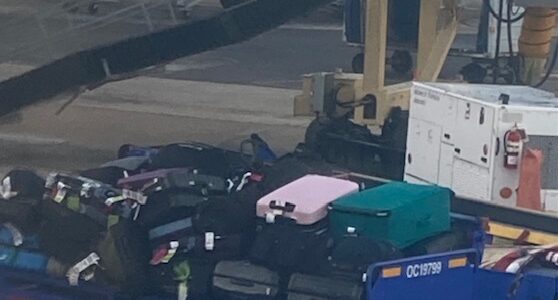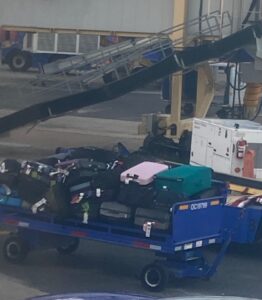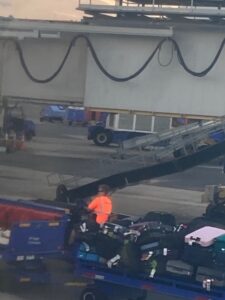
Gate Checked Luggage – How Does It Get Inside The Plane?
We have all heard the announcements by the airline staff asking for passengers to “gate check” luggage because the flight is full.
We’ve also seen people drop off strollers and other bags just before the door to enter. What happens to these articles?

In many cases, either someone has to trudge up the exterior steel or aluminum staircases to fetch them and then load them manually into the belly of the aircraft. A number of airports and airlines also have stairways with parallel chutes that enable ground crew to simply toss the bags, strollers, and other items so that they flow down to someone on the ground level without having to go up and down steps during inclement weather or extremes of heat, cold or icy conditions.
Gate-checked luggage is stored in the same cargo area as the other checked in luggage. The process to get them into the plane is different because it involves more manual labor. Obviously, this process is rife with danger and the source of many on the job accidents. at the airport. The workers’ duty is to safely transport these large items, but some items can also be heavier than anticipated. Especially where airline passengers are reluctant to incur the costs of checked baggage, commercial air travelers have become very creative at packing more and more into their “carry on luggage.” With no weight limit to these items destined to be taken onboard, Airport injury lawyer Doug Landau has helped other passengers load 50, 60 and 70 pound bags into the overhead bins! And removing such densely packed bags and suitcases from overhead is also rife with danger.

As for the airline staff or airport personnel who may be assisting in the luggage loading process, severe weather conditions can also increase the likelihood of injury. Slipping on de-icer, jet fuel, snow, water, ice, or oil while carrying a heavy or large-sized bag can lead to fractures, herniations and even traumatic brain injury on the Air Operations Area (“AOA”). Inside the belly of a large jet, there is still limited room and workers’ maneuverability is restricted, making pushing, pulling and re-positioning large and heavy suitcases a recipe for back injury, joint dislocations, rotator cuff tears and ripped biceps. Even with their knee pads, gloves and work boots, the human body can only stand up to so much wear and tear. With inadequate staffing and the rush to get jets out on time, the major airlines are all facing significant workers comp injury numbers. Airline employee shortages, especially in the heavy, manual labor positions, like baggage handling, puts more pressure and stress on those workers who are sometimes forced to work longer shifts, overtime and even when already injured.
..
If you or someone you care for has been injured due to the regulations of an airline or have experienced a similar injury, please do not hesitate to contact call us at (703) 796-9555 or email frontdesk@landaulawshop.com
